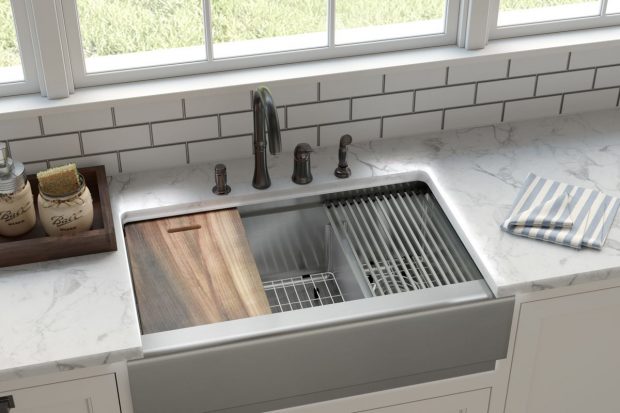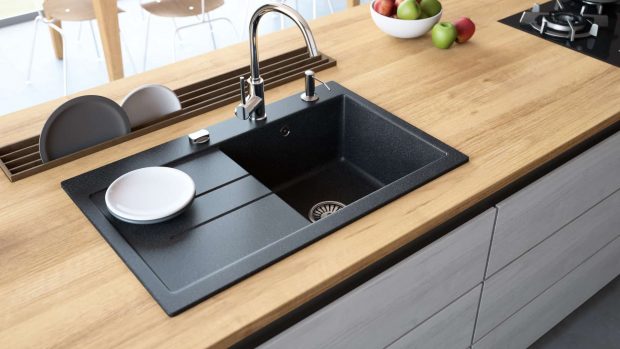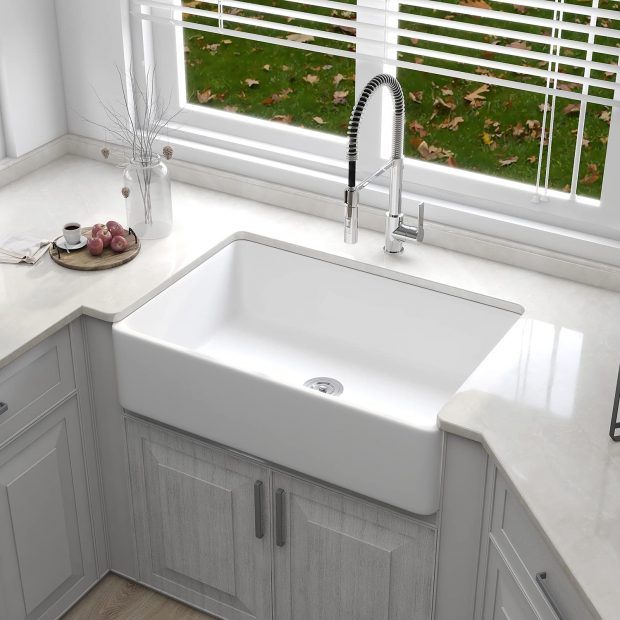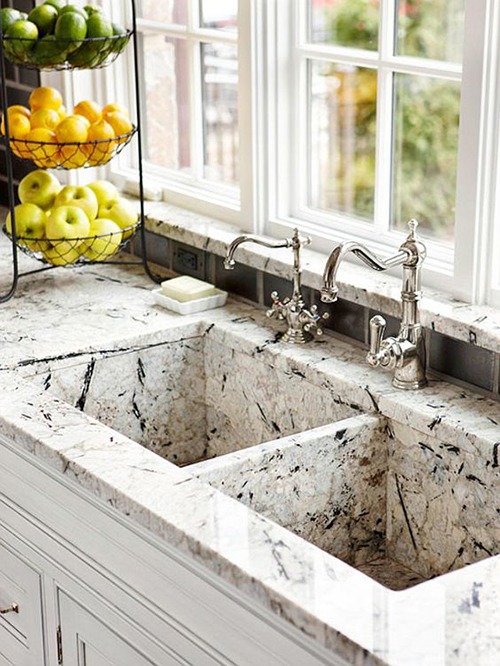We might not always think about it, but the kitchen skin is one of the most used features of any home. Taking a little extra time in selecting it will save you a lot of trouble down the road. Many homeowners prefer to select the kitchen sink first – as it will be the central hub of kitchen activities – and then design the rest of the kitchen around it. Does utility, shape or material take the front seat for your next sink acquisition?
Thankfully, there’s a variety of options to choose from, each with its own pros and cons. Let’s take a look.
Choosing a Sink Material
This step is essential in selecting your kitchen sink. Think durability, difficulty in cleaning and aspect.

Stainless steel sinks.
Clearly one of the most common and reliable products on the market and for good reason.
Pros: Affordable price range, very durable and easy to clean. It is also very flexible and tends to blend into any environment – be it traditional or modern.
Cons: If your region has issues with hard water, water spots can in time become a problem.
While the metal can scratch, although brushed stainless steel can easily be buffed out. In fact, many manufacturers offer bottom grids (or wire trays) to prevent just that.
Porcelain sinks.
Porcelain sinks have been around forever, and are now making a comeback. We tend to associate them more with bathroom design, but any self respecting rustic kitchen enthusiast should at least consider purchasing one.
Pros: Traditional, non-porous, easy to clean material that gives an authentic look to vintage designed kitchens. Wide colour pallet.
Cons: They can chip, leaving a black mark behind. Metal pans and other materials can leave black marks as well as scuffs on the surface. They may be challenging to remove, but not impossible.
Granite composite sinks.

As the name already suggests it, it is the most durable and scratch (or chemical) resistant material on the market today thanks to the high density of rock and polymer particles that compose its surface.
Pros: High resistance to scratches, chips and water spots.
Cons: Lighter coloured sinks can be affected by staining, recommending some special maintenance.
Natural stone sinks.
Unlike their ceramic counterparts, stone basins are more resistant to soap scum buildup. This translates into less time spent on its weekly maintenance. Soapstone is a buyer’s favourite when it comes to natural stone sinks.
Pros: offers an exotic or authentic period look, depending on your design. Easy to clean. Durable. Can easily blend with your countertop material.
Cons: A little on the premium price side. Requires special cleaning products. The surface can scratch and chip.
Number of Basins To Have and Ideal Basin Configuration
It is important to strike a balance between the material and type of kitchen sink you need. If you know your kitchen to be particularly busy and you are looking for a more utilitarian feel, stainless steel or granite composite are usually the best choice. They come, of course, in multiple shapes and sizes.
Large, single kitchen sinks
This is a general category which can include both farmhouse (apron) type sinks and in-counter sinks. These sinks have no divided basin.
Pros: Easy to soak and clean big pans (especially if the basin is a deeper type) or prepare large food quantities.
Cons: they can be less versatile when it comes to washing, rinsing or draining dishes and cutlery. You cannot separate the dirty dishes from the clean ones. You need extra care when thawing meat to avoid contaminating other utensils.
Two Different-Sized Basins
A standard 60/40 kitchen sink usually has one basin 18 inches wide and another one that is 14 inches wide. The goal is to clean up the large one while prepping food or dishes in the smaller one.
Pros: Perfect for separating tasks such as cleaning dishes and preparing food. You can also use it when trying to avoid the dishwasher (soaping it up in one basin and rinsing the water in the other)
Cons: A smaller basin means a harder time washing and soaking large pots, pans or dishes.
Two Equal-Sized Basins (or a 50/50 sink).
Pros: While it also allows task separation, it offers a sense of symmetry to incorporate in your design.
Cons: The cost of installation for the dual drain doubles, as well as maintenance. Smaller room for that extra large pan to soak.
Three Basins
Preferably two large ones plus an additional smaller one for the garbage disposal.
Pros: Garbage disposal can be used independently of the sink.
Cons: Not necessarily a con, but keep in mind it is a larger investment, so it’s definitely not something to aim for if you’re going for a dorm-room feel. It also requires more space. Some models may have the garbage disposal in the middle, forbidding you to sweep the scraps directly off the counter.
Considering the Shape of Your Sink
Farmhouse Sink
Usually single, large basins with a distinctive apron front giving it its signature vintage look.
Pros: Cozy, vintage vibe. Easy access for kids or shorter people because it usually overlaps the edge of the countertop.. If you decide on porcelain you will also enjoy a much wider colour pallet.
Cons: It puts aesthetics ahead of function. This should not necessarily be a problem, unless your tastes in design change drastically.
The Double Farmhouse Sink
The double-size variation of the cottage type sink.
Pros: Shares the benefits of a double sink.
Cons: It offers a reinterpretation of a vintage style rather than direct quotation.
Rounded Sides
Pros: Easier to clean than its squared corner counterpart.
Cons: May clash with the rest of the kitchen if you are going for a brutalist design.
Built-in Drainboard
Pros: Very convenient if you’re a fan of hand washing. Also great for draining dishes and allowing fruits and veggies to dry.
Cons: This wider contraption will eat up more of your countertop space.
Of course, this is just the tip of the iceberg when it comes to deciding on your kitchen sink, but will at least set you out on the right path. Take the necessary time to choose the kitchen sink that best suits your needs and personality.
Because if we were to choose one thing that can speak volumes about a household and its homeowner, the kitchen sink would definitely make the top three list.





